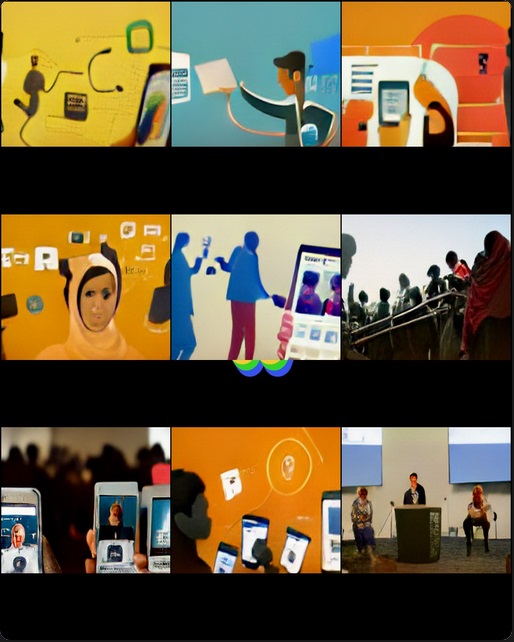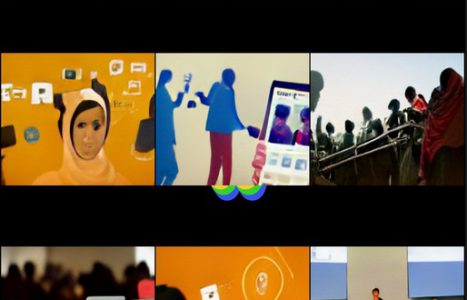“I remember when we first stepped off the plane. Everything was foreign. Unfamiliar. Uninviting. Even the air in my lungs left me short of breath. We came here to find refuge. They called us refugees […]”.
(JJ Bola, 2018)
JJ Bola came as a refugee from the Democratic Republic of the Congo to the UK when he was six years old (UNHCR, n.d.). He experienced not having citizenship, nor an ID when he came to the UK. In his early years he was thus already confronted with the question of belonging, as he describes in an interview [1]. From these authentic and real experiences he wrote, among others, this poem.
JJ Bola is convinced that real voices – voices of people who have experienced what they talk or write about – have more power to challenge stereotypical representations of refugees as well as their stigmatization. With his poem his goal is to do exactly that. He does not want to evoke pity for refugees, but to display solidarity towards refugees, equality and humaneness.
To raise awareness about this topic, he made use of social media, since in his eyes, the suggestion of new connections on social media as well as the use of hashtags to spread the message to potentially interested people, is the reason why it is easier to raise awareness online on social media than offline [2].
This kind of self-representation is a good example of a real refugee voice, spread, to challenge today’s news media’s representations of refugees. Let us look at other examples.
Once I was a Refugee is for instance another example of such an intention. It is a Finnish social media campaign (see Twitter & Facebook) where people with refugee background posted pictures of themselves with a written statement saying “Once, I was a refugee. Now I am…” and then stating their current occupation. This campaign’s aim was to give refugees a voice and challenge news media’s sometimes hostile coverage of refugees and their representation of uselessness.
For this campaign, refugee selfies were spread online from refugees themselves – in this case, however, contrary to most news media articles, it was the actual selfie the refugee had been taken that was shared with the public.
By using the hashtag #EnnenOlinPakolainen (#OnceIWasARefugee) on social media, the posts went viral and caught the attention of the mainstream media which then also started covering the social media campaign of refugees representing themselves. That way, these pictures were shown on national news and on television, increasing the reach of the campaign enormously [4].
As I mentioned in my previous post, the actual refugee selfie is rarely visible in the (news) media. This is also what a film production team from Berlin thought when they came up with the idea to produce a documentary about the flight of refugees by only using photos and videos taken by the refugees themselves on their flight to another county. The mobile phone is an important device for a lot of refugees on their flight. They use it to organize their escape for example for GPS, for information exchange and research, for communication but also to record their journey [5]. The mobile phone of a lot of refugees is therefore a personal digital archive with photos and videos from their flight. This kind of authentic first-hand material is, however, rarely shown in news media. It is, however, showing the flight of a refugee from their, and only their, perspective: it is material from the refugee gaze – a perspective that is mostly hidden in media representations of refugees [6].
For the documentary #MyEscape, this first-hand material was edited by the production team in close collaboration with the refugees. It is therefore not completely representing the refugee gaze, as it is edited (though in close collaboration with the refugees themselves) and accompanied with interview narratives of the refugees conducted by the production team [5].
If you are interested in the documentary, you can watch it below or under this link (unfortunately only available in German):
These were examples of actual self-representation of refugees in different ways. However, as I also mentioned in my previous post, there is a difference between the refugee selfie and the photo of a refugee taking a selfie. The former can be seen as self-representation (depending on the context), the latter, however, less so. The latter is the picture that is shown in news media without giving enough context and leaving out the individuality of each refugee, their stories and names – their humaneness [2], [4], [8], [9].
A well-known picture of a refugee taking a selfie was taken in Germany. The story behind the picture / selfie also shows that the visibility of a refugee selfie poses certain dangers for the refugee him-/herself. It is the story of the selfie of Anas Modamani, a Syrian refugee, who was photographed the moment he took a consensual selfie with Angela Merkel, the former Federal Chancellor of Germany. The picture of Modamani taking the selfie went viral due to him being incorrectly identified as one of the bombers in a terrorist attack in Brussels airport and metro station in 2016 [9]. The selfie was intended for Modamani use only; the picture of him taking the selfie, however, went viral and caused danger to Modamani and threatened his safety.
This kind of misinformation, which went viral online, but also the stereotypical representation of refugees in news media, often dehumanizing refugees, do contribute to a certain perception some people have about refugees, perceptions of fear of or anger towards refugees for example. The question is, can self-representation of refugees help to challenge these representations and ultimately the public’s perceptions?
I will try to explore this question in more depth in my next post. What are your thoughts on this? Feel free to leave comments below.
One quote of JJ Bolas poem reflects exactly that same topic of media representation. It shows that people are sometimes not well informed and are missing information to build a whole picture:
“I remember one day I heard them say to me they come here to take our jobs, they need to go back to where they came from, not knowing that I was one of the ones who came.”
(JJ Bola, 2018)
References
[1] Phoenix, A. (2017, May 10). JJ Bola, No place to call home. MIROnline. Retrieved on October 3, 2022 from http://mironline.org/jj-bola-interview/
[2] Godin, M. & Doná, G. (2016). “Refugee Voices,” New Social Media and Politics of Representation: Young Congolese in the Diaspora and Beyond. Refuge, 32 (1), 60-71. Retrieved on October 2, 2022 from https://refuge.journals.yorku.ca/index.php/refuge/article/view/40384/36384
[3] Word Up. (2016, November 7). Word Up – JJ Bola – Refuge [Video]. YouTube. Retrieved on October 9, 2022 from https://www.youtube.com/watch?v=qxBECNTkw5U
[4] Nikunen, K. (2019). Once a refugee: selfie activism, visualized citizenship and the space of appearance. Popular Communication, 17 (2), 154-170. DOI: 10.1080/15405702.2018.1527336
[5] #MyEscape (n.d.). About. MyEscapeFilm. Retrieved on October 3, 2022 from http://www.myescapefilm.de/2016/11/07/about/
[6] Georgiou, M. & Leurs, K. (2022). Smartphones as personal digital archives? Recentring migrant authority as curating and storytelling subjects. Journalism, 23 (3), 668–689. DOI: 10.1177/14648849211060629
[7] Sasse, E. (Director). (2016). #MyEscape. WDR; Deutsche Welle. Retrieved on October 3, 2022 from https://www.youtube.com/watch?v=qDcM4Yj7kBI
[8] Chouliaraki, L. (2017). Symbolic bordering: The self-representation of migrants and refugees in digital news. Popular Communication, 15 (2), 78-94. DOI:10.1080/15405702.2017.1281415
[9] Risam, R. (2018). Now you see them: Self-representation and the refugee selfie. Popular Communication, 16 (1), 58-71. DOI: 10.1080/15405702.2017.1413191

